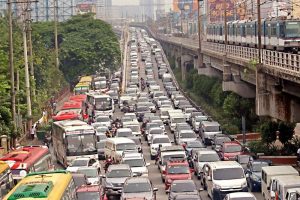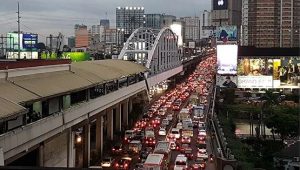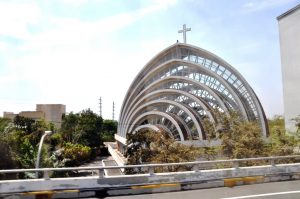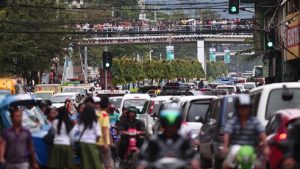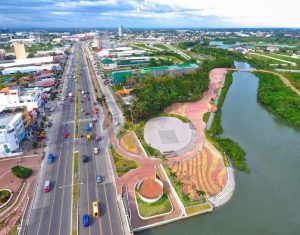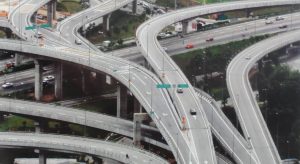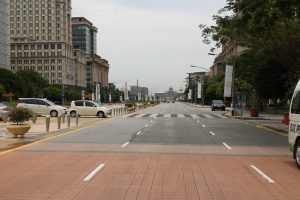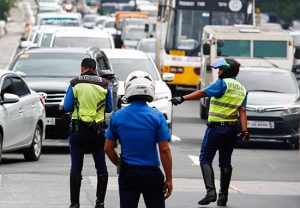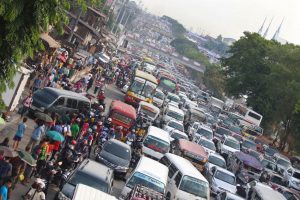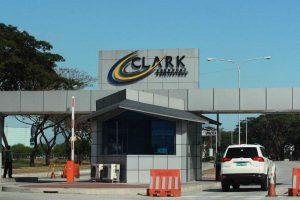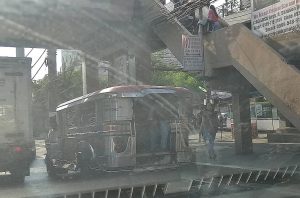I’ve been driving around Metro Manila since 1983 and I’ve seen how the traffic has become heavier every year for the past 36 years. When I started working in 1989, Manila to Makati during the heaviest morning rush hour traffic took just 30 to 45 minutes. Today, Manila to Makati takes around two to three hours, depending on the weather and if there’s a sale in one of the major malls.
In 1999, I moved to Project 8, Quezon City and worked in Sta. Rosa, Laguna. Every morning, my wife Shawie and I would leave before 6:15 AM, drive along EDSA from Muñoz to Magallanes, and catch the 7:00 AM mass at St. Alphonsus or Magallanes Church. After the mass ends at 7:30 AM, she’ll catch a cab to her office in Makati while I drive to Laguna and make it to work before 8:30 AM. And this was during the construction of the SLEX Skyway. Today, my wife and I could be fired for chronic tardiness if we still worked at our old jobs. We now work from home.
Economic Growth and Traffic Congestion
Let’s face it: Traffic in Metro Manila is really bad. The traffic problem slowly built itself up as the national economy improved because with more money, more people bought more vehicles, new buildings were built, and increased commercial activities gathered a denser number of the population in a relatively small area, resulting in congestion. Vehicle sales became one of the catalysts for economic growth because more vehicles means more jobs for more people while increased mobility spurs spending that further fuels the economy.
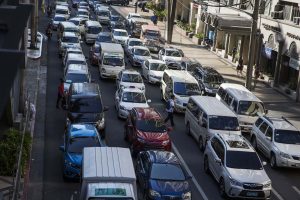
Most main roads in Makati City are congested because of the density of people living and working in a small area.
Some would disagree with this logic and argue that fewer cars could alleviate the traffic congestion, which now affects not only Metro Manila but also majors cities like Batangas, San Fernando, Baguio, Cebu, Cagayan de Oro, Davao, and others. In the past, some lawmakers and government officials even want to limit vehicle sales but vehicular volume is not the real problem. Today’s traffic problem is caused by many factors, not just the volume of vehicles, and to solve it, all these factors must be addressed. The solution will not magically happen overnight because the traffic problem was already brewing before the current administration, or even the previous ones, came into power. Working on the solution might even take several administrations afterwards.
For Every Problem, There’s Always a Solution
The famous scientist, Albert Einstein, once advised his students to “learn from Nature”. Thus, to solve the current traffic problem, we should learn from the natural order of things, like how a million ants can travel from their nest to a food source in a single “ant highway” and not cause congestion. Ants cooperate with one another to accomplish their tasks. They do not just sit idly, complain or chat. They have a queen that they all work for but they do not have leaders who command them what to do while they are moving. They move individually and work together for the good of their colony. But humans are not ants and we all have our individual agenda. We just need to work together for the good of the nation.
So, how will we tackle the traffic problem? First, let’s begin with the mindset that “for every problem, there’s always a solution”. To concede that the problem is “hopeless” makes the task impossible but to realize that there is a solution makes the task more doable. One of the more concrete solutions was offered by former Iloilo Vice Mayor Victor Facultad. His suggestion involves the implementation of the Three E’s – Engineering, Education and Enforcement. This is what they implemented in Iloilo City to curb the impending traffic congestion as their local economy began to grow.
Engineering Solutions Work Better Than Politics
Like ants, we should STOP talking and START moving. The Duterte Administration’s “Build, Build, Build” program is an example of their “call to action”. The President promised to find a solution to the traffic problem and he’s currently working on it. Building more roads, highways, bridges, skyways, and flyovers will help manage the flow of traffic to ease the congestion. While we are currently stuck in traffic because of the numerous construction and roadwork, we will reap the benefits soon enough. I was in Malaysia in 1999 and traffic was bad because of all the road works being done by the government under Prime Minister Mahatir. Despite the drastic increase in the volume of vehicles in Malaysia today, traffic remains manageable because of the expanded road network.
Mahatir did not limit use of vehicles or the sales of vehicles but even encouraged it. He spurred the Malaysian economy with the foundation of Petronas, their national oil company, which fed the increased fuel consumption brought about by the increased number of cars with the establishment of Proton, their national automotive manufacturer. But Mahatir did more than that: He decongested the capital city, Kuala Lumpur, by transferring the seat of government to another region, Putra Jaya, and built roads to connect cities and provinces. He created new commercial areas like Cyber Jaya, their tech hub, the Genting Highlands, their mountain resort, Sepang, their motorsports center, Malacca, their UNESCO Heritage City and tourist destination, and other commercial, industrial, agricultural and tourism centers to create increased job opportunities and commerce around Malaysia. Mahatir simply prioritized sound economic and engineering solutions instead of petty politics with the implementation of his “Malaysia 2020” vision that he introduced in 1991. The Malaysians are now reaping the benefits with their country’s strong global economic status.
UVVRP Does More Harm Than Good
Some traffic control programs, like the Unified Vehicular Volume Reduction Program (UVVRP) actually does more harm than good. Implemented in the early 1990s as a stop-gap measure and more popularly known as “Color Coding” before it became “Numbers Coding”, it obviously does not work. Traffic volume in the metropolis was not reduced and traffic congestion has become worse. The “constables” or traffic enforcers of the Metropolitan Manila Development Authority (MMDA) are more focused on apprehending drivers of vehicles that are banned for the day than they are in apprehending drivers who wantonly violate existing traffic laws and cause danger to other road users. Most of the MMDA enforcers are wired to look for UVVRP violators instead of flagging down drivers who deliberately drive against the flow of traffic or those who obstruct the flow of traffic. Sometimes, if not often, MMDA enforcers cause traffic by their improper way of accosting UVVRP violators.
Another side effect of the UVVRP is the prevalent parking problem. Most families in the metropolis now have two or more cars to beat the “Numbers Coding” scheme and some of the extra cars are parked on the streets, which obstruct traffic flow, or on sidewalks, which inhibits pedestrian use and further creates traffic congestion. If a household has two cars and one is illegally parked on the road, imagine the millions of illegally parked cars occupying valuable usable space on the streets just to beat the ineffective UVVRP. Furthermore, if that household with two cars has two qualified drivers, then both cars will be on the road on the days when these cars are not banned. In effect, the UVVRP has increased the volume of vehicles on the road instead of reducing it. As an engineering solution, it has proven to be a failure and must therefore be scrapped. Continuing the UVVRP is like watching a dog chase its tail.
Spreading the Volume Outwards
Once the UVVRP has been scrapped, most families will go back to becoming a one-car household, especially those with just one qualified driver or those with limited budgets. Those who opt to have multiple cars will be compelled to allocate parking spaces inside their property or their illegally parked vehicles will be towed and impounded, which is the recent mandate of the President to the mayors of the cities within the metropolis. The used car market will be flooded with a lot of second-hand cars and many of these will be sold mostly in the provinces. The volume of vehicles in the metropolis will be reduced and the streets will be cleared of illegally parked cars.

If we can only crush illegally parked cars with a tank like what Mayor Arturas Zuokas of Vilnius, Lithuania did.
Congress and the Filipino people must also support the President’s initiative to move the seat of government away from Metro Manila. Moving to Clark will undoubtedly decongest the metropolis and spread employment and commerce to the neighboring provinces of Bulacan, Pampanga, Tarlac and Pangasinan. Roads to and from Clark will be improved and expanded to keep up with increased traffic. Increased travel and commercial density in the area will improve the local economy, which will attract more people to work and live in Pampanga, thus further decongesting the Metro. Manila-based career government employees should accept being transferred to a new territory because, as public servants, they’re there to serve the people and not their own personal interests. If they can’t cope with the transfer, then they should resign and find employment elsewhere or take an early retirement. After all, government service is a choice, not a sentence. Malaysia showed that it can be done through intelligent planning, sound engineering and strong political will, why can’t we?
In Part 2 of our Unsolicited Advice on Managing Metro Manila Traffic, we will be tackling more Engineering solutions such as steel flyovers, intersection controls, PUV modernization program, designing better PUV loading/unloading zones, using modern technology to manage traffic, and hitting the habitual traffic violator where it hurts the most. Stay tuned.
 Power Wheels Magazine A Notch Above
Power Wheels Magazine A Notch Above

